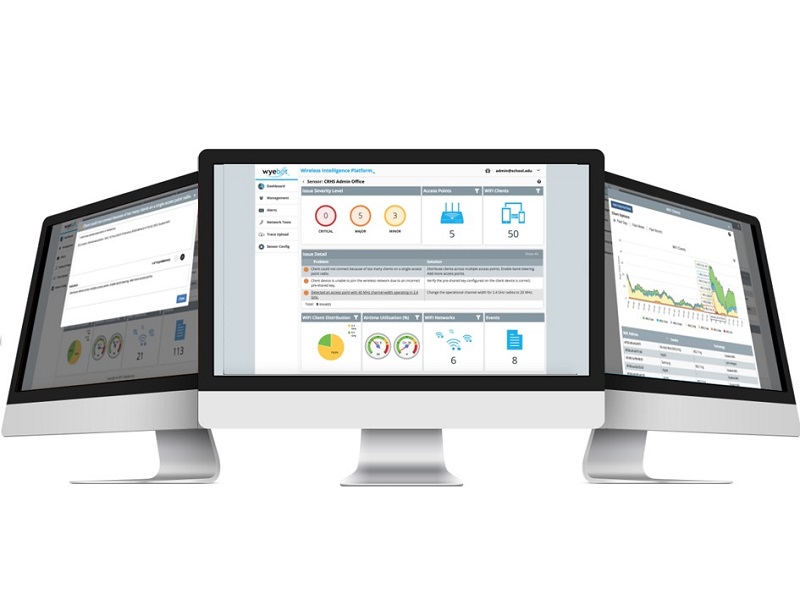WiFi 6E advantages
WiFi 6E is the designated name for any WiFi-capable product that operates in the new unlicensed 6GHz wireless spectrum.
These devices are the only ones allowed to operate in this spectrum, with all older devices, including earlier-released WiFi 6 devices, restricted to the 2.4Ghz and 5GHz bands.
By limiting 6GHz access to 6E devices, regulatory bodies have ensured these new devices have sole use of 14 more 80MHz channels and seven more 160MHz channels.
Thanks to this, these channels should have fewer interference and congestion issues.
These new channels also mean that hospitals can add 6E devices to their networks without worrying about overcrowding the channels on their existing 2.4GHz and 5GHz frequency bands.
The second main advantage offered by 6E is its extremely-low latency: as low as under one millisecond.
As latency is the time it takes for one data packet to travel from a user device to an AP or vice versa, latency this low translates to instantaneous responses for all mouse clicks and keyboard and voice commands.
Thirdly, the security protocol WPA3 is standard on 6E devices. This protocol has more-robust encryption than WPA2 and provides better security and compliance with healthcare regulations like HIPAA.
Real-world examples
With these advantages, hospitals with WiFi 6E will experience:
- Fewer delays in downloading or sending all files; this includes extremely-large files such as MRI, radiography, and ultrasound images. This is also due in part to the faster data rates of WiFi 6
- Better WiFi-enabled voice calls and videoconferencing
- Better-quality telemedicine sessions
- Enhanced security
- Improved user experience for patients, medical professionals, staff, and guests
How hospitals can implement WiFi 6E
Budget appropriately: An upgrade requires that a hospital not only have 6E devices, but also 6E-capable infrastructure. This includes APs, switches, and cables. All must be upgraded in order for users to use the new technology.
Review network utilisation: It is important to review utilisation over the last 4-12 months to predict which floors or other areas will see the most improvement in network performance from the upgrade.
These areas are the priority.
As upgrading an entire facility will take several months, it is important to start the upgrade where it is most needed and where users will experience the most benefit.
This will be the floor or area with the most-dense deployment of WiFi-connected devices.
Perform a site survey: A survey of the facility will determine the best place to station APs.
Since the 6GHz spectrum uses shorter wavelengths than either the 2.4GHz or 5GHz, these wavelengths struggle to travel long distances and experience greater degradation from obstructions like concrete and metal walls, doors, ceilings, and floors.
For this reason, it might not be possible to station new, 6E-capable APs in the exact position as existing APs.
A site survey will identify all areas of possible interference so that IT professionals can determine the best network design.
Analyse existing power: Doing this will help to determine if support is available for WiFi 6E APs.
These APs are usually tri-radio with support for 2.4GHz, 5GHz, and 6GHz frequency bands.
This design causes them to need more power than older-model Aps so facilities must be sure they can meet that increased energy demand.
Work with leadership: Working with hospital managers will help to keep the upgrade as minimally intrusive as possible. This includes leadership from IT, maintenance, patient services, and financial services.
Consistently review network analytics and benchmark performance metrics: Analytics from the entire WiFi network ecosystem are critical to have both before, during, and after the upgrade.
These analytics should include end-user quality metrics so that hospital administrators and IT professionals know if the upgrade is having the desired effec, and can identify and resolve incompatibility issues before patients and medical staff are impacted.
An indepth survey will need to be carried out to ensure hospitals can implement WiFi 6E and use it to its full advantage
How WiFi automation supports cost-effective upgrades
Hospitals and other healthcare facilities can use WiFi automation platforms to simplify network optimisation before, during, and after an upgrade.
These platforms automate the pro-active testing and analysing of the WiFi network, connected devices, infrastructure, and the nearby RF environment.
Depending on the platform, facilities will receive:
- Real-time notifications
- Historical data on long-term performance trends
- 24/7 detection and notification of network abnormalities
- Automatic recommended resolutions
- Automatic, scheduled network testing
- Up-to-date end-user quality metrics
- Remote, automated troubleshooting
- Historical analytics and wireless traces for deeper, more-comprehensive network insights
In addition to providing these critical insights, these platforms help minimise operating expenses by reducing WiFi problems and troubleshooting times. They also support futureproofed WiFi optimisation, thereby providing a reliable network that helps all users perform tasks more efficiently for higher user satisfaction.
With their support, facilities have automatic access to the analytics necessary for cost-efficient upgrades, such as:
- Past and present network utilisation analytics
- Constant visibility into network and device performance, reducing the need for a site survey: IT professionals will have real-time insight into what is affecting connectivity and how issues can be resolved
- Pro-active alerts at the first sign of a problem
With this, upgrading a network is simplified, which means that IT professionals have more time to devote to other critical responsibilities and a healthcare facility can focus on providing the best lifesaving services to all patients.
